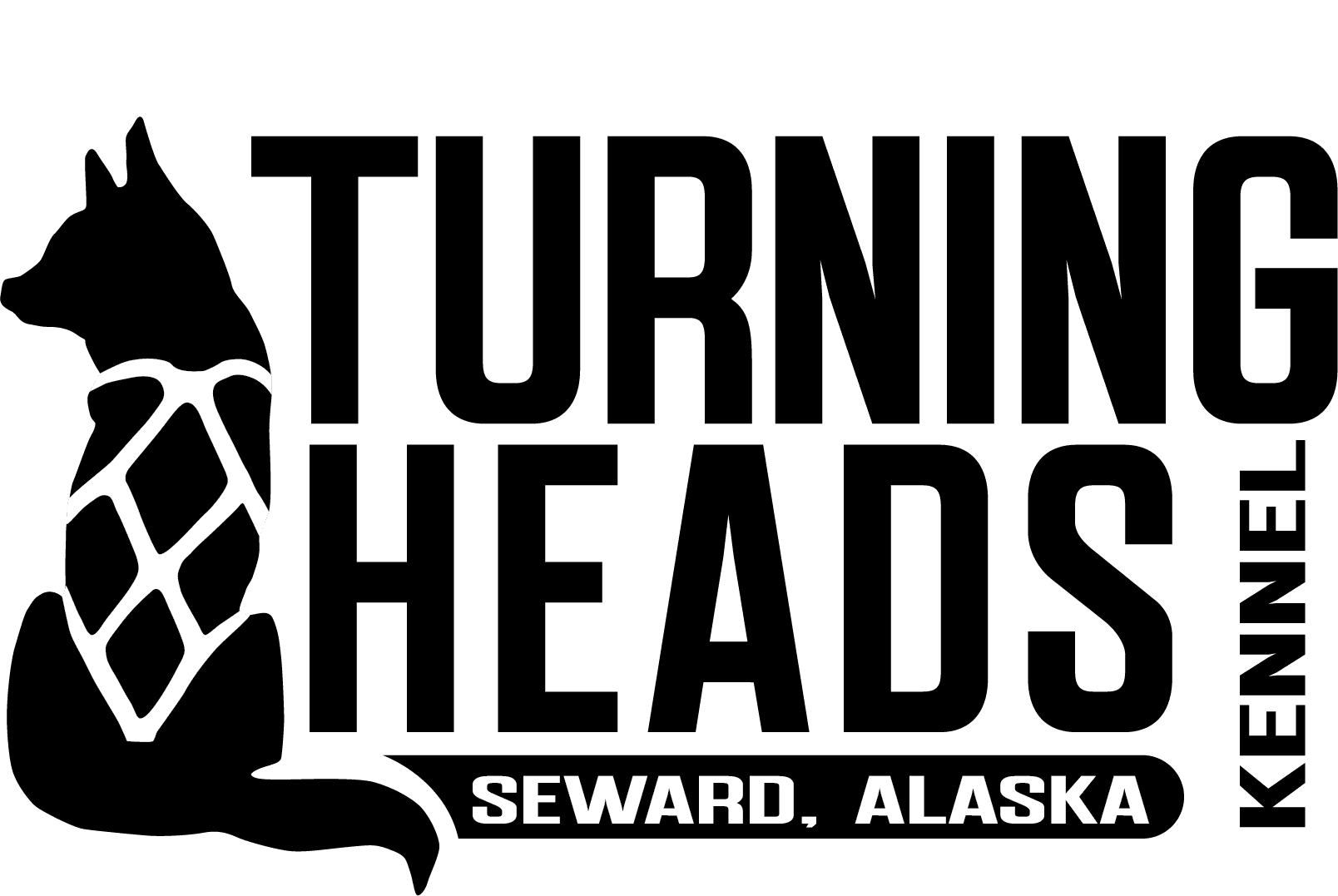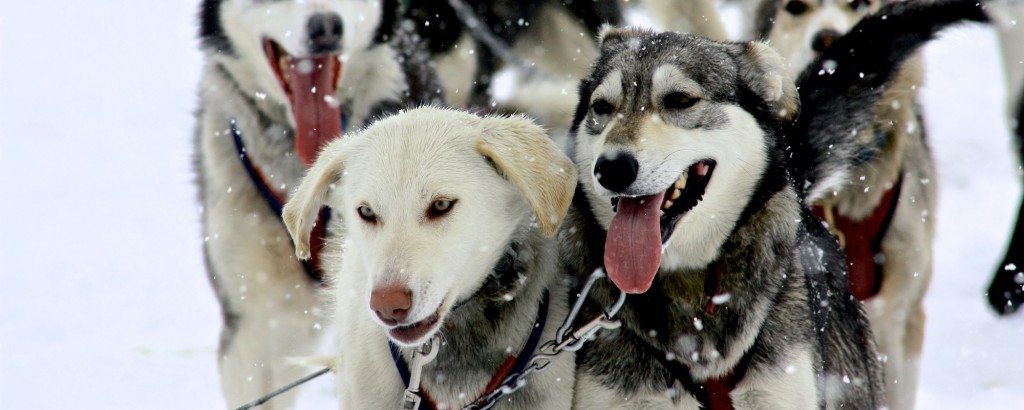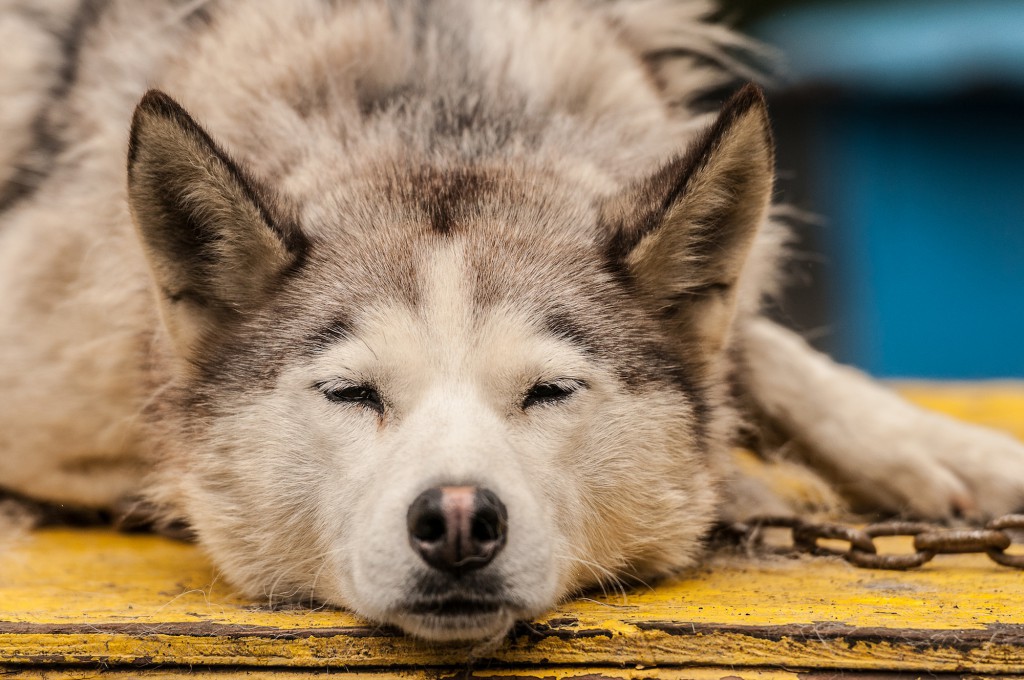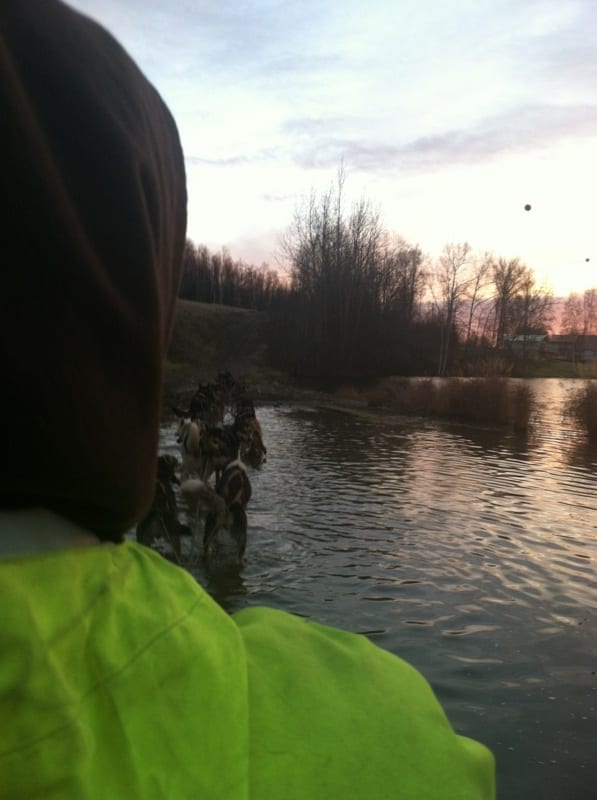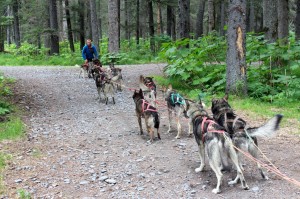Sled Dogs: An Overview
Sled dogs are dogs that have been trained to pull sleds across snow. In months where there is no snow the dogs train on dirt and sleds are substituted for carts, ATVs, or even vehicles. Travis and I primarily use ATVs for training purposes and use carts for our summer tours. While we have never run dogs on our truck, we know many mushers who have; it is a very efficient way to train lots of dogs at once.
While any dog is technically capable of becoming a sled dog, those specifically bred for the purpose of running and pulling show the most athletic talent on the trail. There are three main breeds of dog used today: The Siberian husky, the Alaskan malamute, and the Alaskan husky.
The Siberian husky is the most well-known sled dog breed as it is typically used in movies, advertisements, and on postcards. The malamute is primarily associated with freight hauling and weight-pull competitions, but played a crucial role in Alaska’s early development as a freight-hauling dog. Here at our kennel, we focus on racing and training Alaskan huskies who are a highly versatile breed of sled dog and are the dog of choice in dog sled races due to their speed, stamina, and drive.
Common Sled Dog Breeds
Siberian Huskies – The Traditional Sled Dog
When you think of sled dog, it’s hard not to picture a beautiful Siberian Husky. While less popular in today’s racing circuit than the Alaskan Husky, the Siberian husky has many years of history in Alaska. Teams of Siberian huskies were used to haul freight and mail over supply trails in Alaska during the winter.
The most famous of these dogs was a Siberian husky named Balto from Nome, Alaska. Balto was a black Siberian husky owned by Gunnar Kaasen, Balto is known for his roll in helping to save the village of Nome from a deadly diphtheria outbreak. In 1925, Nome was only accessible by dog team in the winter. When children in Nome suddenly started contracting diphtheria, life-saving serum was transported hundreds of miles by dog sled relay. Balto, was the lead dog on the final team that delivered the medicine in to Nome. His story is commemorated through film, book, and statue: there is a statue of Balto in Central Park in New York City. For more information on Balto and the 1925 Serum Run check out Balto’s True Story.
As a breed, Siberian huskies are known for their inquisitive minds as well as their independent nature. As pet dogs, they can prove to be a nuisance as they love to roam and explore.
We own one Siberian husky named Faraday. She knows exactly what she likes and what she doesn’t like and can often be found slinking around outside acting as if she is about to get into trouble of some sort. She rarely chooses to come inside our home, instead preferring the comfort of a doghouse. She is happiest, it seems, when left to her own devices. We treasure the moments when she chooses to grace us with her presence and her affection as they are somewhat few and far between.
Although not as popular in dog sled races, there are still many mushers who choose race Siberian huskies. Lisbet Norris of Anandyr Siberians is a good friend. Lisbet and her family now have the longest running Siberian Husky Kennel in the world. She will be competing in Iditarod 2015. In the 2014 Iditarod, Travis spent many hours on the trail with Mike Ellis and his team of Siberian Huskies. Karen Ramstead, of Canada, is another musher who races Siberian Huskies. Lev Shvarts runs both Siberian huskies and Alaskan Huskies and will be competing in the 2015 Iditarod — Lev is one of the first people to teach me how to run sled dogs. I started my journey training sled dogs back with Lev in Winchenden, MA back in 2010 and am excited to be sharing the race trail with him this year.
Alaskan Malamutes – Freighting Sled Dogs
These are the big, fluffy dogs used primarily during the Gold Rush for freight hauling as well as for trap lining. In general, the malamutes tend to be slow when compared to teams of Siberian Huskies and Alaskan Huskies. Teams of malamutes were renowned for their incredible strength. Today, malamutes primarily compete in weight pull competitions but were historically important in Alaska as freight-hauling dogs.
The Alaskan Husky – The Racing Sled Dog
Contrary to popular belief, the Alaskan husky is not a purebred dog. Many Alaskan huskies have genetic traits linking them to Siberian huskies, Alaskan malamutes, German-shorthaired pointers, Irish setters, and other hunting dogs. These breeds were bred in for various reasons but, in the end, the goal was to create a better sled dog.
When giving a sled dog tour, we often explain to our guests that the Alaskan husky is an expensive northern breed mutt – but it’s important to note that we have extensive family trees on our dogs. Knowing these family trees helps us to make good breeding decisions and gives us a better idea of the litter we will produce.
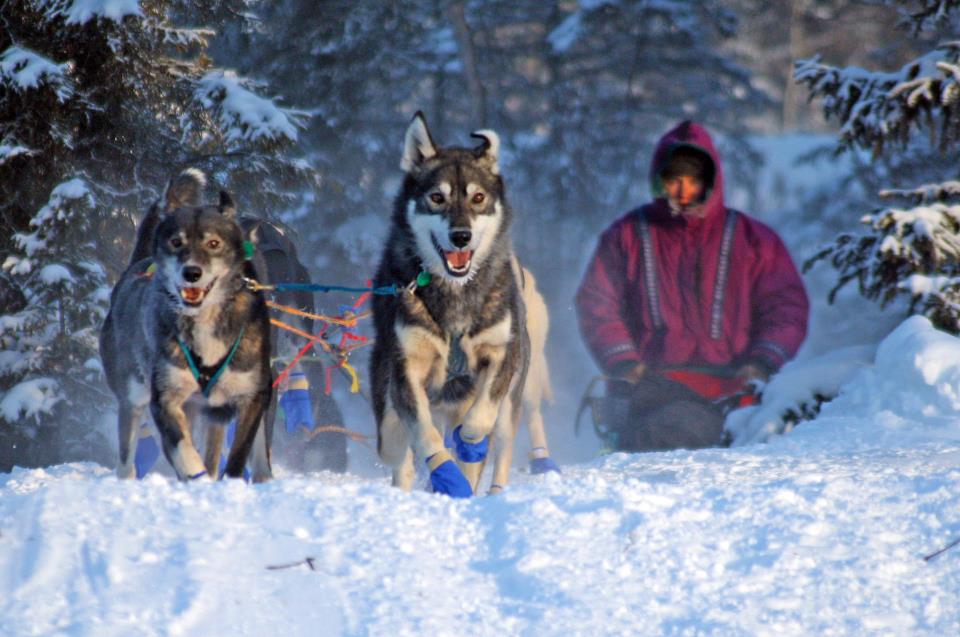
One thing that is often very misleading to people unfamiliar with the Alaskan Husky is that the Alaskan husky can come in a wide variety of colors, sizes, and hair lengths. Because of this, it may be easier to think of the Alaskan Husky as a “type” of dog, with many different “sub-types.” For example, a musher who is breeding dogs for a 30 mile sprint event is going to be looking for different traits than a musher who is breeding dogs for a 1,000 mile event. Yet, if you ask these mushers what kind of dogs they have, they would both answer “Alaskan Husky” despite the fact that because the dogs are being bred for different purposes they are, ultimately, going to differ physically. In general, dogs participating in long distance racing such as the 1,000 mile long Iditarod or Yukon Quest, tend to larger framed bodies than those who participate in sprint events which generally are no longer than 30 miles.
Because the Alaskan husky is more of a loose categorization than an actual breed, we also routinely see widely varying personality traits. We have exuberant dogs who are quick to show affection as well as shier dogs who prefer keeping to themselves and focus strictly on their jobs. This is because the Alaskan Husky is a melting pot of talented working athletes. Their high energy, their love of running, and their physical build help define these incredible dogs. For more information on Alaskan Huskies, check out Aliy Zirkle and Allen Moore’s “Dog Mushing Basics” as well as the Iditarod Trail Committee’s “What Is A Sled Dog.”
A Very Brief History of Sled Dogs In Alaska
Historically, sled dogs were the primary method of transportation during the winter months in Alaska. Natives used sled dogs as a way to help with their nomadic lifestyle as they followed herds of caribou. The dogs helped natives move their camps efficiently in the cold winter climates.
During the gold rush in Alaska, sled dogs provided a vital lifeline for the miners in the interior with the outside world. Ships would unload cargo in Seward, Alaska (where our kennel is located) and sled dogs would then deliver that cargo as far as 1200 miles away in the town of Nome, Alaska.
Positions a Sled Dog Can Have In A Team
In dogs sledding, where the dogs are located in the team affects what they have to do. The most involved position belongs to the lead dog, who has to listen and take commands. Other positions on the team include the swing dogs, the team dogs, and the wheel dogs. Most dogs can run on either the left or right side of the gangline and in multiple positions.
Lead Dogs
The most important position in the team belongs to the lead dog. The lead dog or dogs are at the front of the team. While it is more common, especially in media portrayals of dogsledding to see two lead dogs, many lead dogs actually do a better job working alone. The lead dog is responsible for listening to the musher, responding properly to commands, and making sure the team stays on the trail.
When determining new candidates for lead, we look at the 3 A’s: Attitude, Aptitude, and Athleticism. Dogs who run up front need to have at least two of these traits but ideally all three to be a candidate for a lead dog in our kennel.
Swing Dogs
Swing dogs are the pair of sled dogs who run directly behind the lead dogs. The swing dogs are generally leaders as well. Later on in the training season, we may put a pair of young dogs in this position if we see that they have the potential to lead.
This position is a great place to start potential leaders as they are up front in the team but do not have all the pressure of being a lead dog. Dogs in swing still have ability to learn the association between a musher’s commands and the movement of the team. Because of this, it’s thought that running dogs in swings help prepare them for lead dog training later on.
Wheel Dogs
Wheel dogs run directly in front of the sled. Generally, mushers run larger dogs here. Wheel dogs received their name because they are responsible for helping turn the sled. Some mushers prefer running a single wheel dog as when dog sledding the back of the team and the sled can get pulled into corners. By running only one wheel dog, the dog has more mobility when going through twisting trail.
Team Dogs
Team dogs are the dogs in the every other position in the team. There is no special delineation for each set of team dogs. Although they are generally thought of as interchangeable, a good musher knows exactly where to place team dogs to maximize efficiency and work in their team.
Do you have any other questions about sled dogs? Let us know in the comments below!
